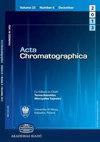The use of an RP-HPLC-UV method for the analysis of oxcarbazepine in the presence of its preservatives; stability studies and application to human plasma samples
IF 1.7
4区 化学
Q3 CHEMISTRY, ANALYTICAL
引用次数: 0
Abstract
A simple, sensitive, selective, accurate and precise method was developed and fully validated for determination of oxcarbazepine (OXC) in presence of their preservatives and determination of oxcarbazepine (OXC) in human plasma. A reversed phase liquid chromatography (RP-HPLC) with UV detection techniques were applied for separation and quantification of studied drug OXC. Successful separation of the drug from methyl paraben (M.P.), propyl paraben (P.P.) and potassium sorbate (P.ST.) was achieved on a Kromasil C18 column (5 μm particle size, pore size 300 Å, l × I.D. 250 × 4.6 mm). The mobile phase that contain aqueous 0.05M potassium dihydrogen phosphate buffer (pH 7): acetonitrile, (50: 50, %v/v). The method was linear over concentration ranges 5.0–50 μg mL−1 for OXC. Bioanalytical validation of the developed method was carried out according to US-FDA guidelines and revealed a good linear relations over a range of (5.0–50), (0.5–10), (0.05–0.15), and (1.0–10) μg mL−1 for OXC, M.P, P.P, and P.ST, respectively, with a correlation coefficient (R2) of more than 0.999. Limit of detection (LOD) were 1.15, 0.03, 0.01 and 0.04 μg mL−1 for OXC, M.P, P.P, and P.ST, respectively, Intra and inter-day precisions, calculated as percentage relative standard deviation (% RSD), were lower than 2.0%. The developed method can be applied for routine drug analysis, therapeutic drug monitoring and bioequivalence studies through the analysis of plasma samples taken from blood bank.用反相高效液相色谱-紫外分光光度法分析奥卡西平中防腐剂的含量稳定性研究及其在人血浆样品中的应用
建立了一种简便、灵敏、选择性好、准确、精密度高的奥卡西平(OXC)检测方法,并进行了充分验证。采用反相高效液相色谱法(RP-HPLC)和紫外检测技术对所研究药物氧合碳进行分离和定量。采用Kromasil C18色谱柱(粒径为5 μm,孔径为300 Å, 1 × id),对羟基苯甲酸甲酯(M.P.)、对羟基苯甲酸丙酯(P.P.)和山梨酸钾(P.ST.)进行了分离250 × 4.6 mm)。流动相为含0.05M磷酸二氢钾缓冲液(pH 7):乙腈(50:50,%v/v)。该方法在5.0 ~ 50 μg mL−1浓度范围内呈线性。结果表明,OXC、M.P、P.P和P.ST分别在(5.0 ~ 50)、(0.5 ~ 10)、(0.05 ~ 0.15)和(1.0 ~ 10)μ mL−1范围内呈良好的线性关系,相关系数(R2)均大于0.999。OXC、M.P、P.P和P.ST的检出限(LOD)分别为1.15、0.03、0.01和0.04 μg mL−1,日内和日间精密度(以百分比相对标准偏差(% RSD)计算)均小于2.0%。该方法可应用于常规药物分析、治疗药物监测以及通过分析血库血浆样本进行生物等效性研究。
本文章由计算机程序翻译,如有差异,请以英文原文为准。
求助全文
约1分钟内获得全文
求助全文
来源期刊

Acta Chromatographica
化学-分析化学
CiteScore
4.00
自引率
0.00%
发文量
55
审稿时长
2.3 months
期刊介绍:
Acta Chromatographica
Open Access
Acta Chromatographica publishes peer-reviewed scientific articles on every field of chromatography, including theory of chromatography; progress in synthesis and characterization of new stationary phases; chromatography of organic, inorganic and complex compounds; enantioseparation and chromatography of chiral compounds; applications of chromatography in biology, pharmacy, medicine, and food analysis; environmental applications of chromatography; analytical and physico-chemical aspects of sample preparation for chromatography; hyphenated and combined techniques; chemometrics and its applications in separation science.
 求助内容:
求助内容: 应助结果提醒方式:
应助结果提醒方式:


